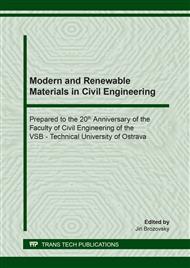[1]
AÏTCIN, Pierre-Claude. Binders for durable and sustainable concrete. New York: Taylor & Francis, 2008. ISBN 978–0–203–94048–8.
Google Scholar
[2]
AÏTCIN, Pierre-Claude a Sidney. MINDESS. Sustainability of concrete. New York: Spon Press, 2011. Modern concrete technology, 17. ISBN 978-0-203-85663-5.
Google Scholar
[3]
ALTOUBAT A. Salah and David A. Lange. Creep, Shrinkage, and Cracking of Restrained Concrete at Early Age. ACI Materials Journal. 2001, 98(4).
DOI: 10.14359/10401
Google Scholar
[4]
BAZANT, Zdenek. RILEM draft recommendation: TC-242-MDC multi-decade creep and shrinkage of concrete. Model B4 for creep, drying shrinkage and autogenous shrinkage of normal and high strength concretes with multi-decade applicability. Materials and Structures. 2015, 48(4), 753-770.
DOI: 10.1617/s11527-014-0485-2
Google Scholar
[5]
BAZANT, Zdenek, Vladimir KRISTEK and Jan VITEK. Drying and cracking effects in box – girder bridge segment. J Struct Eng. 1992;118(1):305-321.
DOI: 10.1061/(asce)0733-9445(1992)118:1(305)
Google Scholar
[6]
CAJKA, Radim, Martina SMIRAKOVA and Jana VASKOVA. Experimental Testing of Shear Resistance on SFRC Slab Structures. Materials Science Forum. 2017, 893, 363-368.
DOI: 10.4028/www.scientific.net/msf.893.363
Google Scholar
[7]
CAJKA, R., P. MYNARCIK and J. LABUDKOVA. Experimental measurement of soil-prestressed foundation interaction (2016), International Journal of GEOMATE, 10 (4), pp.2101-2108.
DOI: 10.21660/2016.22.5385
Google Scholar
[8]
COLLEPARDI, Mario. The New Concrete. 2nd. Italy: Grafiche Tintoretto, 2010. ISBN 8890377720.
Google Scholar
[9]
CSN EN 1992-1-1. Eurocode 2: Design of concrete structures – Part 1-1: General rules and rules for buildings. Prague: Czech standards institute, (2006).
Google Scholar
[10]
CSN EN 206. Concrete – Specification, performance, production and conformity. Prague: Czech Office for Standards, Metrology and Testing, (2014).
Google Scholar
[11]
ED. BY A. BENTUR. Early age cracking in cementitious systems: report of RILEM Technical Committee 181-EAS Early Age Shrinkage Induced Stresses and Cracking in Cementitious Systems,. Bagneux: RILEM Publ, 2003. ISBN 2912143330.
DOI: 10.1617/2912143632.023
Google Scholar
[12]
Guide for modelling and calculating shrinkage and creep in hardened concrete. Farmington Hills, MI: American Concrete Institute, 2008. ISBN 978-0-87031-278-6.
Google Scholar
[13]
HAVLASEK, Petr and Milan JIRASEK. Multiscale modelling of drying shrinkage and creep of concrete. Cement and Concrete Research. 2016, 85, 55-74.
DOI: 10.1016/j.cemconres.2016.04.001
Google Scholar
[14]
HOLT, Erika E. Early age autogenous shrinkage of concrete. Espoo: Technical Research Centre of Finland, 2001. ISBN 9513858707.
Google Scholar
[15]
HOUST, Y. F. Carbonation shrinkage of hydrated cement paste. In: Proc. 4th CANMET/ACI International Conference on Durability of Concrete. (1997).
Google Scholar
[16]
INTERNATIONAL FEDERATION FOR STRUCTURAL CONCRETE FIB. Model code 2010: first complete draft. Lausanne, Switzerland: Fédération internationale du béton, 2010. ISBN 978-288-3940-956.
Google Scholar
[17]
JANULIKOVA, Martina. Comparison of the Shear Resistance in the Sliding Joint between Asphalt Belts and Modern PVC Foils. Applied Mechanics and Materials. 2014, 501-504, 945-948.
DOI: 10.4028/www.scientific.net/amm.501-504.945
Google Scholar
[18]
JANULIKOVA, Martina and Marie STARA. Reducing the Shear Stress in the Footing Bottom of Concrete and Masonry Structures. Procedia Engineering. 2013, 65, 284-289.
DOI: 10.1016/j.proeng.2013.09.044
Google Scholar
[19]
KROPACEK, Michal and Jiri SAFRATA. Volume changes of cements from different locations depending on time. Transactions of the VŠB – Technical University of Ostrava, Civil Engineering Series. 2015, 15(1), 11-20. ISSN 1213-1962.
Google Scholar
[20]
MYNARCIK, Petr. Technology and Trends of Concrete Industrial Floors. Procedia Engineering. 2013, 65, 107-112.
Google Scholar
[21]
MYNARCIK, Petr, Jana LABUDKOVA and Jiri KOKTAN. Experimental and numerical analysis of interaction between subsoil and post-tensioned slab-on-ground. Jurnal Teknologi. 2016, 78(5-4).
DOI: 10.11113/jt.v78.8530
Google Scholar
[22]
NAVRATIL, J., Structural analysis of bridges, legitimate conservatism and obsolete theories, (2004), Concrete Engineering International, 8 (1), pp.17-19.
Google Scholar
[23]
NAVRATIL, Jaroslav and Radim CAJKA. Crack Control in Reinforced Concrete Liquid Retaining Structures. Materials Science Forum. 2017, 893, 410-415.
DOI: 10.4028/www.scientific.net/msf.893.410
Google Scholar
[24]
NAVRATIL, J., M. CIHAL, J. KABELAC and R. STEFAN. Nonlinear analysis of reinforced and composite columns in fire. Frattura ed Integrita Strutturale. 2017, 11 (39), pp.72-87.
DOI: 10.3221/IGF-ESIS.39.09
Google Scholar
[25]
NAVRATIL, Jaroslav and Milos ZICH. Long-term deflections of cantilever segmental bridges. The Baltic Journal of Road and Bridge Engineering. 2013, 8(3), 190-195.
DOI: 10.3846/bjrbe.2013.24
Google Scholar
[26]
NAVRATIL, J. and M. ZICH. Long-term deflections of long-span bridges, (2010), 5th International Structural Engineering and Construction Conference CHALLENGES, OPPORTUNITIES AND SOLUTIONS IN STRUCTURAL ENGINEERING AND CONSTRUCTION,, pp.385-390, ISBN:978-0-415-56809-8, WOS:000290418600060.
DOI: 10.1201/9780203859926.ch60
Google Scholar
[27]
RILEM draft recommendation: TC-242-MDC multi-decade creep and shrinkage of concrete. Materials and Structures. 2015, 48(4), 753-770.
DOI: 10.1617/s11527-014-0485-2
Google Scholar
[28]
STRASKY, Jiri, Jaroslav NAVRATIL and Stanislav SUSKY. Applications of Time-Dependent Analysis in the Design of Hybrid Bridge Structures. PCI Journal. 2001, 46(4), 56-74.
DOI: 10.15554/pcij.07012001.56.74
Google Scholar
[29]
TAZAWA, Ei-ichi. Autogenous Shrinkage of Concrete. 1st Ed. New York: E, 1999,411 s. ISBN 04-192-3890-5.
Google Scholar
[30]
VINKLER, Marek and Jan L. VITEK. Drying shrinkage of concrete elements: Structural Concrete. Structural Concrete. 2017, 18(1), 92-103.
DOI: 10.1002/suco.201500208
Google Scholar


